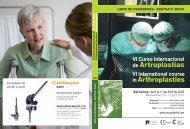cadera / hip - Active Congress.......
cadera / hip - Active Congress.......
cadera / hip - Active Congress.......
Create successful ePaper yourself
Turn your PDF publications into a flip-book with our unique Google optimized e-Paper software.
JUEVES / THURSDAY<br />
168<br />
grafting is an effective method in treating<br />
polyethylene wear and associated osteolysis<br />
in selected patients. Dislocation rates may<br />
be reduced with use of the direct lateral<br />
approach and this reduction is reported as<br />
a signifi cant fi nding of this study. Isolated<br />
liner exchange is becoming increasingly<br />
common as a revision procedure following<br />
total <strong>hip</strong> arthroplasty. A new simple computer-assisted<br />
technique of measuring and<br />
quantifying lesional area on standard AP and<br />
lateral radiographs is described, and provides<br />
a useful tool in the clinical setting.<br />
CONSTRAINED<br />
LINERS IN REVISION THA<br />
W. Paprosky<br />
Rush Arthritis & Orthopaedic Institute<br />
St. Luke’s Medical Center<br />
Chicago, Illinois, USA<br />
USE OF CAGES IN<br />
ACETABULAR REVISION<br />
SURGERY<br />
P. Beaulé<br />
Associate Professor<br />
University of Ottawa, Canada<br />
Revision acetabular reconstructions represent<br />
a great challenge to orthopaedic surgeons,<br />
particularly with severe segmental<br />
and cavitary pelvic defi ciencies. In general,<br />
a porous-coated, noncemented cup with at<br />
least 50% host bone coverage can be used, if<br />
the option of cementless fi xation is chosen.1<br />
Defi ciencies are fi lled with allograft, either<br />
structural or particulate. However, defi ciencies<br />
requiring greater than 50% coverage by<br />
allograft should be supported by a metal back<br />
ring with a cemented cup.1,2 This protects the<br />
graft from mechanical overload during its revascularization<br />
phase. The majority of these<br />
defi ciencies fall into type III and IV defects as<br />
defi ned by the American Association of Orthopaedic<br />
Surgeons classifi cation system.2,3<br />
The most common metal rings have been the<br />
Muller acetabular ring4 and the Burch–Schneider<br />
antiprotrusio cage.5,6 Another design<br />
is the ring hook cages fi rst introduced by Kerboull7<br />
and later adapted to the Muller ring by<br />
Ganz,8 and also available as the Restoration<br />
GAP Cup9 (Stryker–Howmedica–Osteonics,<br />
Allendale, NJ). The techniques to insert<br />
these devices are variable in terms of optimal<br />
position and allograft use. More specifi cally,<br />
little emphasis has been placed in restoring<br />
normal <strong>hip</strong> anatomy, with the majority of the<br />
surgical technique focusing on placing the<br />
cage on intact host bone.6,9<br />
There is clinical and biomechanical evidence<br />
that joint reaction forces increase with<br />
superior and lateral placement of the <strong>hip</strong><br />
center.10-12 In his classic article, Johnston<br />
et al10 demonstrated that inferior and medial<br />
placement of the <strong>hip</strong> center resulted in a<br />
maximum reduction of the joint reaction force<br />
and the moment-generating requirements of<br />
the muscles. Delp et al12 showed, with a 3dimentional<br />
computer model, that increasing<br />
the <strong>hip</strong> center by 2 cm in the superior and<br />
lateral direction decreases abductor moment<br />
arms by 28%. However, increasing the <strong>hip</strong><br />
center in the superior direction alone, along<br />
with prosthetic neck length compensation,<br />
had little effect on moment arms. Joint reaction<br />
forces similarly increase with superior and<br />
lateral <strong>hip</strong> center placement of greater than<br />
25 mm, as shown in an experimental model<br />
reported by Doehring et al.13 These authors<br />
demonstrated that with a 25-mm displacement<br />
of the <strong>hip</strong> center, the joint reaction force





